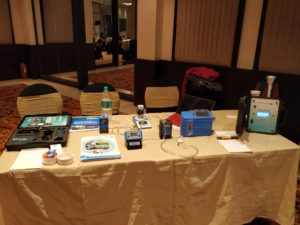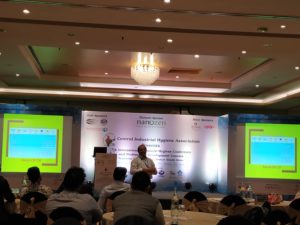3 day conference of Industrial Hygienists in New Delhi is being organized by Central Industrial Hygiene Association (CIHA) from 3-5 February. The central industrial hygiene association is the recognized leader in providing hygiene and health solutions for reducing unintentional deaths and disabling injuries. At the conference organized by CIHA, the secretariat of India Ban Asbestos Network (iBAN) – Environics Trust shared its experience while working with workers and communities in different part of India. Environics Trust along with Developing World Outreach Initiative (DWOI) is planning to do an air sampling in some of the key identified areas where asbestos contamination can be blatantly seen.
The platform gave an opportunity to meet the Industrial Hygienists across the country and exchange the learnings and chances to collaborate.
What does an Industrial Hygienist do?
Industrial hygienists keep workers, and the communities surrounding workplaces, healthy and safe. They also ensure compliance with laws and regulations in the work environment. Industrial hygienists assess health risks in a workplace; sample air to determine if there are harmful substances present; measure noise levels in factories; and provide practical advice on how workers can be protected from job-related health and safety risks.
How are OSHA & Industrial Hygiene related?
Developing and setting mandatory occupational safety and health standards involves determining the extent of employee exposure to hazards and deciding what is needed to control these hazards, thereby protecting the workers.
Industrial hygienists are trained to anticipate, recognize, evaluate, and recommend controls for environmental and physical hazards that can affect the health and well-being of workers. Important IH responsibilities include:
- Identifying, measuring and analysing workplace health hazards and exposures (chemical, physical, biological, ergonomic) that can cause sickness, impaired health, or significant discomfort.
- Recommending hazard control strategies to eliminate/reduce hazards and employee exposure to hazards.
The main objectives behind the conference are-
- Awareness of industrial hygiene and health related issues in various industries
- Reduce work place health hazards by giving appropriate and feasible controls to protect the health of the employees.
- To provide safe workplace environment by introducing a working knowledge of the fundamentals of hazard recognition, evaluation and control.
- Design/Redesign of workplace as per ergonomic principles
- Conduct training programmes for various chemical and engineering industries in plant and institute by counselling employees regarding the health hazards and necessary precautions to avoid adverse health effects.
- Educate management, supervisors and workers regarding industrial hygiene and health related problems and its effect on human body.
- Cost effective consultancy for industries.
- To educate about national & international regulations and laws that involves safety and health in the workplace.
- Promotion of research & development activities in the industrial hygiene field.
- Development of analytical methods for collected air samples.
- Short term certificate courses in institute.
- Conduct of epidemiologic studies to uncover the presence of occupational-related illness.
- Getting affiliated with international bodies in the same field.
Some important points of discussion from the conference
- Kathleen Murphy from USA, shared why it is important to have industrial hygienists and their stewardship program for the same.
- Indrajeet Roy, an Industrial Hygienist, shared his experience on different types of clothing materials and how important it is to know what material suits in different factory.
- Jignesh Vadher, an independent ESH consultant from Tamil Nadu, shared a lot of understanding on the importance of ergonomics.
- Kailash an OSH expert gave a detailed understanding on the difference between OSHA-18001 and ISO 45001 and how the new clause can bring in meaningful changes for the worker’s safety and industries’ accountability.
- Representative from Nanozen technologies, shared about the latest sensor product (HSE 4.0) to monitor air pollution, which can give real time reading.
- iBAN shared an overview on the existing situations among the Asbestos-Cement product manufacturing plants and other industries where asbestos and its products are being used. And where lack of safety is causing nuisance among the workers, their family and communities.
Important Links-
Some Photos of the conference

Display of Equipment’s during the Conference

Dr. Kathleen Murphy during her presentation

Dr. Kailash sharing insights on OSH

Recent Comments